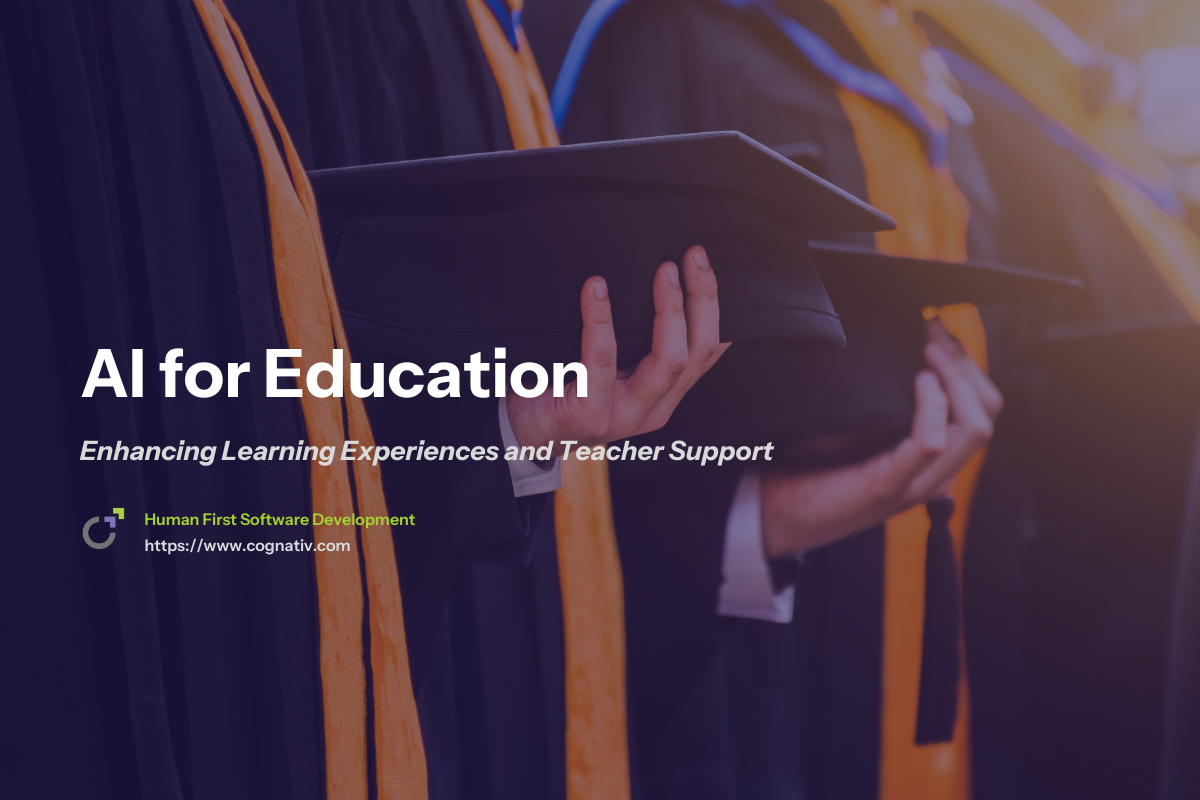AI for Education: Enhancing Learning Experiences and Teacher Support
The rapid acceleration of artificial intelligence is reshaping industries globally, and education is no exception. AI for education is being adopted around the world, with educators and institutions in numerous countries embracing these technologies.
Once perceived as slow to adopt technological change, schools and academic institutions are now embedding AI solutions into core instructional and administrative functions. As AI systems continue to develop and evolve, their power to transform educational experiences becomes increasingly evident.
From generative AI platforms that personalize learning experiences to intelligent systems that reduce administrative workloads, AI is redefining how knowledge is delivered, absorbed, and measured. This transformation is not simply about efficiency gains; it’s about creating a more adaptive, inclusive, and student-centered learning ecosystem.
As these technologies scale, AI literacy among educators and the ability of institutions to integrate AI responsibly will determine the real impact on classrooms and learning outcomes, shaping the education of tomorrow.

Strategic Benefits of AI Tools in Education
AI offers tangible operational and pedagogical advantages, with a key benefit being the positive impact on education by improving access, quality, and inclusivity for all students. One of the clearest benefits is time savings for teachers—AI tools can automate administrative tasks, freeing up teachers' time so they can focus more on building meaningful relationships with students and supporting their social-emotional development. In fact, educators can save up to 7-10 hours each week by leveraging AI solutions, significantly reducing their workload and improving efficiency in teaching routines.
Equally important is personalized feedback. AI systems can provide real-time, adaptive learning support to students, helping them grasp complex concepts at their own pace. Beyond individualized learning paths, AI can detect potential bias in instructional materials, ensuring that classrooms are more diverse, inclusive, and equitable.
For institutions, the integration of AI enables data-driven decision-making in areas such as resource allocation, curriculum optimization, and performance tracking. This strategic visibility allows administrators to align learning outcomes with institutional objectives more effectively.

Building AI Literacy and Driving Adoption
The success of AI in education relies on more than access to technology — it requires AI literacy across the educator workforce. Teachers who understand how to integrate and adapt AI tools are better positioned to make meaningful pedagogical shifts. A deep understanding of AI's advantages, challenges, and effects in education is essential for educators and administrators to make informed decisions about AI integration.
Schools and districts are responding to this need by:
-
Offering structured professional development in AI-powered teaching, including video tutorials and training formats tailored to each person, such as individualized courses or support
-
Encouraging experimentation through workshops, pilot programs, and open-resource sharing
-
Creating collaborative environments where educators can exchange practices and lessons learned
This momentum is visible across multiple levels of education — from K-12 to higher education — and is accelerating as AI tools become more intuitive and accessible.
Key learnings from AI literacy and adoption initiatives highlight the value of comprehensive training, individualized support, and practical strategies for successful integration.

Supporting Teachers Through Intelligent Systems
Teaching has always required a balance between administrative management and instructional leadership. AI now allows educators to tilt that balance toward teaching by helping teachers and administrators manage classroom and school operations more efficiently. Many AI platforms can also be customized to meet district-level needs, supporting administration and implementation across entire educational districts.
Platforms like Google Classroom and other AI-enabled learning management systems give teachers access to:
-
Personalized lesson plan generators, aligned with curriculum standards
-
Real-time student performance dashboards
-
Collaborative resource libraries and peer-to-peer knowledge exchange
By automating repetitive tasks such as attendance tracking and performance reporting, AI gives teachers more time to focus on meeting students where they are, designing deeper learning experiences, and providing personalized guidance.

Advancing Student-Centered Learning
Perhaps the most profound impact of AI in education is its ability to support student-centered learning models. Students AI platforms personalize learning for individual students, adapting to their unique needs and learning styles.
These AI tools can benefit children, especially in diverse and inclusive educational settings, by promoting equitable access to high-quality resources for young learners worldwide.
AI-powered platforms help students:
-
Explore topics at their own pace through personalized content delivery
-
Receive real-time feedback that supports mastery of complex ideas
-
Engage in creative, self-directed projects — from interactive presentations to podcasts and research portfolios
These tools foster critical thinking and problem-solving, while helping students take greater ownership of their learning. Alongside academic learning, it is important to intentionally develop students' social and emotional skills to ensure well-rounded growth. Instead of passive absorption, students become active participants in shaping their educational journey.

Automating Administrative Complexity
Administrative processes often limit institutional agility. AI is increasingly being deployed to automate routine but resource-intensive functions:
-
Attendance tracking
-
Grading and performance reporting
-
Data aggregation and analysis
Beyond efficiency, real-time reporting systems allow parents, teachers, and administrators to collaborate around the same information, improving transparency and accountability.
By reducing friction in the system, institutions can redirect human and financial resources toward innovation, instructional quality, and student support. However, institutions must also rely on careful evaluation of both the risks and benefits when implementing AI solutions to ensure responsible and effective integration.

Schools and Academic Institutions as Catalysts
Schools are no longer passive recipients of technology; they are active drivers of AI integration. Across K-12 and higher education, institutions are experimenting with solutions that enhance access to learning, improve equity, and deliver measurable outcomes. Many of these AI tools are schools loved and widely adopted by educators, reflecting their popularity and trust within educational institutions.
Key adoption patterns include:
-
Hybrid deployments that combine AI platforms with existing LMS infrastructure
-
AI integration into special education to personalize support for diverse learners
-
The creation of innovation hubs and labs where educators test new AI tools and methodologies
These institutional moves signal a broader shift: AI is becoming foundational to how education systems operate.

Student Safety and Wellbeing in the Age of AI
As artificial intelligence becomes increasingly embedded in classrooms, ensuring student safety and wellbeing has never been more critical. The adoption of AI tools and generative AI platforms brings significant benefits to education, from personalized learning to enhanced engagement. However, these advancements also introduce new challenges. Students’ interactions with AI can sometimes expose them to inappropriate content or facilitate academic dishonesty if not properly managed.
To address these concerns, educators and school systems must champion responsible AI practices. This means not only selecting AI tools designed with robust safety features but also actively educating students about ethical and appropriate use of artificial intelligence.
Ongoing monitoring of AI-driven interactions in classrooms is essential to quickly identify and mitigate potential risks. By prioritizing student safety and wellbeing, schools can fully realize the benefits of AI in education while creating a secure and supportive environment for every learner.

Security and Data Protection in Educational AI
With the growing reliance on AI technologies in educational contexts, the security and protection of student data have become paramount for academic institutions. AI tools often process vast amounts of sensitive information, making robust security systems and protocols essential. Schools and districts must implement advanced measures such as encryption, secure data storage, and regular security audits to prevent unauthorized access and data breaches.
Platforms like Google Classroom offer built-in security features that help safeguard student information, but it is equally important for educators and administrators to remain vigilant about potential bias in AI algorithms and ensure that all AI-driven decisions are transparent and equitable.
By prioritizing data protection and security, schools create a trustworthy environment where students can confidently access and learn with AI tools.
Establishing clear guidelines and leveraging trusted resources ensures that educational institutions remain at the forefront of safe and responsible AI adoption.

Best Practices for AI Adoption in Education
Successfully integrating AI into education requires a strategic and informed approach. Educators and academic institutions should begin by fostering AI literacy, ensuring that teachers and staff understand both the capabilities and limitations of AI technologies. Staying current with the latest developments in AI tools and their applications in lesson plans and instruction is essential for making informed decisions that enhance student learning.
When adopting AI-powered solutions, transparency and accountability must be at the forefront. Teachers should receive targeted training on how to use AI to personalize learning, provide real-time feedback, and save time on administrative tasks—freeing them to focus on supporting student growth and development.
Academic institutions should also establish clear policies and guidelines for responsible AI use, ensuring that these technologies are leveraged to improve educational outcomes and support every student’s learning journey.
By following these best practices, schools can unlock the full potential of AI, making learning more effective, efficient, and equitable for all.

Responsible AI: Safeguarding the Future of Learning
While the potential of AI in education is significant, it is not without challenges. Responsible AI implementation must address:
-
Potential bias in data sets and algorithms
-
The privacy and security of student information
-
Clear governance structures around AI usage
Strategic AI adoption must be anchored in ethical standards, transparency, and safeguards that prioritize student well-being and educational equity.

Looking Ahead: AI as a Strategic Enabler
The use of AI in education is more than a technological shift — it’s a structural transformation. As AI capabilities evolve, we will see even more sophisticated solutions for personalized learning, professional development, and assessment.
To fully realize this potential, educators, policymakers, and industry leaders must collaborate to ensure that:
-
AI literacy is embedded in professional training
-
Institutions adopt clear frameworks for responsible AI use
-
Innovation serves to amplify human teaching, not replace it
The future of education will not be defined by technology alone, but by how intelligently and responsibly it is applied to meet students where they are — and prepare them for the world they will inherit.


